

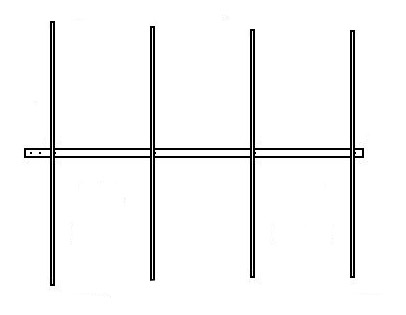
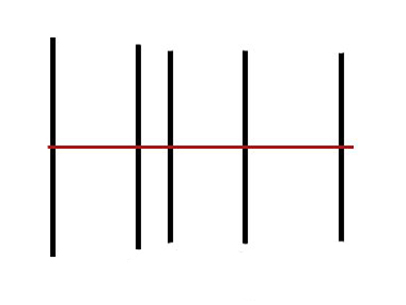
A new trend in Antenna design is to build Antennas that are resonant! What
do you say? Well in the early days of amateur radio nearly everything was
matched by either,
a gamma match, beta match, hairpin match, 75 ohm 1/4 wave coax match, or one
of a few hundred other home made matching devices.
With the advent of modern computer software, it was discovered that Yagi's,
Quad's, and other normally non-resonant antennas could be matched to 50 ohm
coax, by changing
the sizes and the spacing of the elements.
The above photo on the left shows
how many Yagi's looked for 50 years, it was generally assumed that Yagi's
were just low impedance antennas and had to be matched with some type of
aiding device.
The above photo on the right shows
how many Yagi's are being built today, and that they are perfectly happy
with a 50 ohm coax running directly to it, as long as you do install a choke
at that point.
The choke could be a Current Balun (preferred) or a bunch of Ferrite beads
running on the outside of the coax for some length until the coax meets the
mast at least. I know what some of you are thinking
balanced to unbalanced, blah blah blah....... NO.
Balanced to
Unbalanced means there will probably be common mode current trying to run
back down the coax...hence the choke. Even with balanced
single element dipoles there is current that will attempt to run back down
the coax, so you should have a choke in any case. On all antennas. The
exception being on some raised end-fed verticals which
actually need the coax to better balance the antenna electrically and give
the antenna some "ground" path. see: A99 and Imax2000. The terms balanced
and unbalanced are used frequently and vaguely
in amateur radio on many websites, sometimes being used in completely
different uses then described here. That's a long discussion in itself. But
trust me ...you need a Choke regardless of your thoughts
on balanced versus unbalanced.
Back to direct feed:
Is this really better than a matching device? Well all matching devices have
power limits. Why? Well they have wattage limits because what's happening is
the device is heating up as more and more power is running through it...it gets hot! Until it fails (melts), and thats your power limit! So if you are spending
energy heating up coiled wires and iron , your not delivering power to the
antenna. So is it better
to have a direct feed to the antenna? YES.
How much loss is in a matching device....truly its anyone's guess...from .25
db's to 1 to 2 db's have been quoted numbers, but I suspect it depends
greatly on each design.
Is this enough loss to change out your antenna? That decision is up to you.
In my opinion every little bit of loss you can eliminate can go a long way
towards making the rare island contact one day. You just never know.
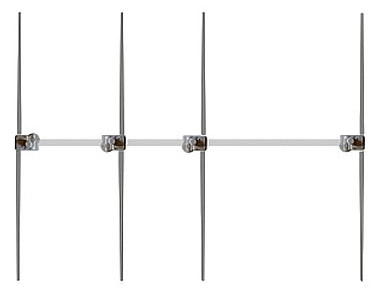
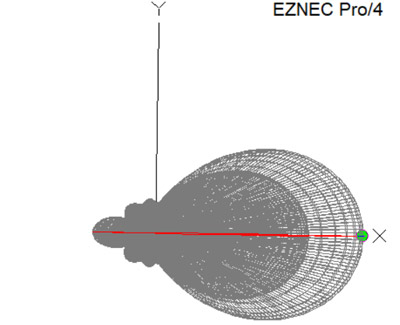
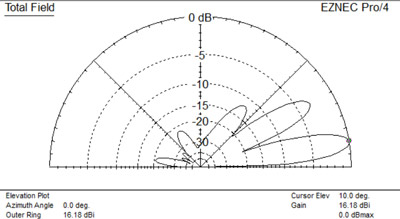
By far the biggest advanced in antenna building has been the advent of computer software designed to show you what the antennas pattern and gain will approximately look like with the parameters you put into it. This has been a big help for the amateur that decides to experiment with antennas and build his own. Like Me ! However there are some things you should know, before jumping into it.
The leader in this software revolution is called Eznec. Most (90%) buy or
find the free version and some may even buy the $100 6.0 version. This
free software was created 30 years ago. Thirty
!!
To put this in perspective, Nintendo came
out 30 years ago! Not Super Nintendo....Nintendo! Remember the original
Duck Hunt ? Well think of that software versus gaming
software built today. No comparison.
Is there an new version that is up to date? Yes there is. That version is
the PRO/4 version, which is updated frequently and is technology-wise
current. So whats the problem?
Well most amateurs haven't blown the dust off their dollar bills that have
been sitting in their wallets for decades, nevermind spending $1100.00 for
the latest version of just software. Did I say $1,100.00 Yes I did.
For that price amateur operators could buy a new Icom 7300!! So they
use the old version ( 30 years old version) and think they are getting
accurate results! They are not. Again think of a PC... 30 years ago versus
today.
You sure you still wanna use that free software?
Ok lets get to it:
The pattern on the left is the Azimuth
pattern, or the pattern of the antenna if you were standing high
above it looking down at it. This is a beam antenna facing to the right or
east if you prefer.
The pattern on the right is the Elevation
pattern, or the pattern of the antenna if you were looking at it at
ground level from the side. It shows mostly the forward radiation lobes
facing to the right or east.
Amateur radio companies are starting to use these patterns to impress you in
their catalogs or in monthly magazine publications, about their antennas. As
with DB gain, these patterns can be manipulated to look great.
The overhead (Azimuth) is actually very very good. as most of the energy is
heading forward , with little or no side lobes to be found, coupled with a
small back lobe (decent Front to Back ratio).
However looking at the Elevation lobe you can plainly see all is not what it
seems. Although not terrible by any means there are still several lobes
other then the main lower lobe going forward, one at a 30 degree angle,
and one at a 55 degree angle. These are wasted angles for the most part, as
in most tough conditions such as distant groundwave or that rare Vietnam dx
contact you want to get, the more energy you can get into the lowest
possible lobe the better. This is often why if you do see an antenna pattern
advertised , it will be pattern number 1 (on the left) and never the pattern
on the right. Again the antenna height above ground , just like DB gain
claimed by manufacturers can have a tremendous effect on what the pattern
looks like. And manufacturers almost never will tell you that.
Ok so whats the benefit of this for the amateur radio operator who is NOT going to build his own antenna? Well
once you get proficient with Eznec PRO/4 you can put in all the antennas you
see and read about in magazines,
once you know the dimensions and you can decide for yourself who is lying to
the public on their claims or at the very least being deceptive with their
claims. As you will have all the answers in front of you.
So if you have dreams or aspirations of being a Big
Gun, you or someone you trust needs to have the updated version of
this software, and then you'll know what your doing. Otherwise your leaving
it to hearsay and
what the manufacturers would have you believe.
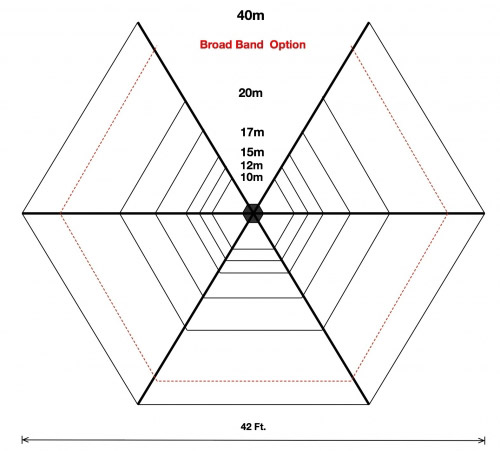
Last but not least the FANTASTIC HEXBEAM !
Wait didn't you say you like Cubical Quads? I did and I do. But for
the most bang for the buck this is the antenna that will get you on all the
bands, and you
will have a good performer. MFJ (if you trust them) is making these
very easy to buy. And you can even get the 40 meter version if you have the
space. Hexbeams are lightweight, easy to turn with an inexpensive rotor,
have very low wind loading, have low noise and work decent even at lower
heights. ( this is a function of them almost being complete loops, even
though they are two element antennas). You will get about 5 dbi of gain
versus your 2 dbi dipole antenna, which can and most likely will be the
difference in hearing that contact , that you can't quite hear on your wire
antenna. I highly recommend for the average amateur radio enthusiast. You
can even build it yourself in about 2 hours time, all you'll need is a
screwdriver. These aren't brand new designs, but new enough to include.
Now will you break every pile-up? No. Will you beat that guy you hate with
the 4 element Cubical Quad or Yagi on the BIG tower he is always bragging
about? No. Will you have a good chance of making thousands of contacts you
would have never made before with a wire , vertical or small Yagi beam? Yes you will. Is it reliable? Yes. Is
the SWR low on every band Yes. Will you
grow to love it? Yes you will.
Last Updated: